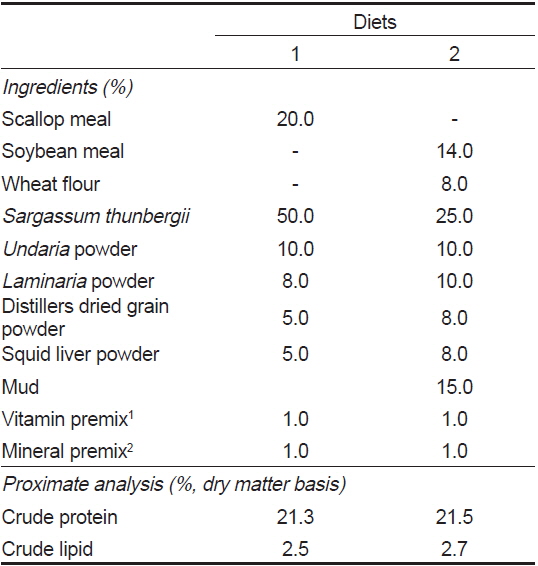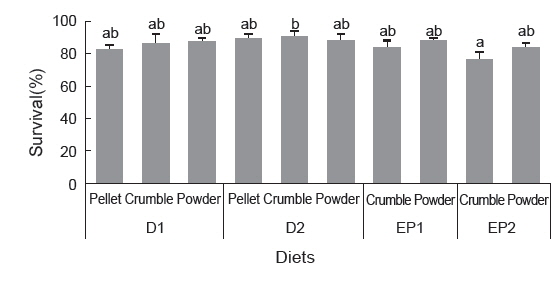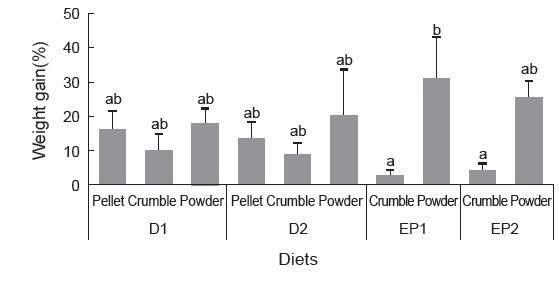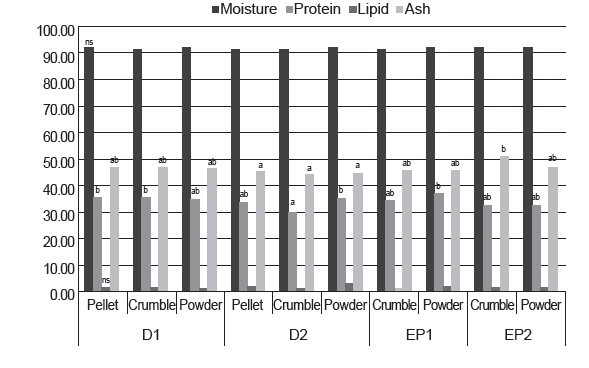



An experiment was conducted to investigate the effects of feeding by different feed types (powder, crumble and pellet) of two different feed formulations with simple dried (D) or extruded (E) conditions on growth and body composition of juvenile sea cucumber Apostichopus japonicus. Triplicate groups of sea cucumber averaging 1.2±0.05 g were fed each of the D1, D2, EP1 or EP2 diets for 12 weeks. Survival of sea cucumber fed D2-crumble was higher than that fed EP2-crumble diet (P<0.05). Weight gain of sea cucumber fed EP1-powder was higher than that fed EP1-crumble and EP2-crumble diets (P<0.05). These findings indicated that simple dried feed could use independently feed type for sea cucumber culture and powder type of extruded feed is also good for sea cucumber culture.
해삼류 중에서 돌기해삼(
해삼은 해저 바닥에 주로 서식하면서 모래나 펄에 섞여 있는 동물과 식물의 사체를 섭취한다. 이러한 해삼의 서식지와 섭식 형태에 근거하여 양어가들은 펄 등의 부드러운 저질을 사료에 혼합하여 공급하기도 한다. 해삼 양식 시 사용되는 양성용 먹이로는 자연산 해조류 분말을 단독 또는 혼합하여 공급(Sui, 1988; Battaglene et al., 1999)하고 있는 실정이며, 배합사료 연구에 사용되는 먹이도 분말 형태의 실험사료를 공급하면서 수행되었다. 이러한 분말 상태의 사료는 해삼이 섭취하기 전에 사료의 영양소가 수중으로 쉽게 유출될 수 있거나 물의 흐름에 따라 분말 사료가 유실될 가능성이 높다. 사료 내 영양소 유출이나 분말사료의 유실은 사료의 원료 조성비, 사료 성형 조건, 사료 형태 등에 영향을 받을 수 있으므로(Lee et al., 1997a, 1997b), 이에 대한 고려가 필요하다. 또한 이러한 사료 분말의 수중 유실은 환경 오염원이 되므로 이에 대한 대책이 필요하다.
고형물 형태의 사료는 분말 형태의 사료와 비교하여 수중에서 유실되는 양과 해수에 의한 수용성 영양소의 용출이 비교적 낮다. 해삼이 pellet이나 crumble 형태의 고형사료도 적절히 섭취하여 소화할 수 있다면 실용사료 형태로 사용될 수 있을 것으로 판단된다. 그래서, 본 연구는 수중에서 배합사료의 풀림 속도가 달라지도록 사료조성비를 달리하고, 성형 조건에 따른 배합사료 형태가 해삼의 성장과 생존에 미치는 영향을 조사하였다.
실험사료 조성을 Table 1에 나타내었다. 실험사료의 주요 단백질 원료는 가리비 분말과 대두박을 사용하였으며, 해조류로 지충이 분말, 미역 분말 및 다시마 분말을 사용하였다. 배합사료 조성물과 사료 제조 조건에 따라 수중에서 풀어지는 속도가 달라지도록 하였는데, 수중에서 잘 풀어지는 사료1의 경우 가리비 분말과 지충이 분말을 각각 20%와 50%씩 첨가하였다. 수중에서 잘 풀어지지 않은 사료2의 경우, 대두박과 지충이 분말을 각각 14%와 25% 첨가하였으며, 점착력이 있는 소맥분을 8% 첨가하였다. 또한, 사료2에 펄을 15% 첨가하였다. 이와 같이 배합사료 조성물이 다르게 설계된 2종류의 실험사료 제조는 각각의 배합사료 조성물을 소형 펠렛기와 extruder로 성형하였는데, 실험 사료 제조방법은 다음과 같다. D1과 D2 사료의 경우, 설계된 사료 원료들을 잘 혼합한 후 원료 100 g당 물 30 g을 첨가하여 펠렛 제조기로 압출 성형한 후, 실온에서 24시간 건조 후 pellet, crumble 및 powder 형태로 가공하였다(D1-pellet, D1-crumble, D1-powder, D2-pellet, D2-crumble, D2-powder). EP1과 EP2 사료의 경우, 설계된 원료들을 분말형태로 잘 혼합하고 Extruder Pellet Mill (Kahl OEE 08 extruder, Germany)을 사용하여 EP를 제조하였다. 제조 조건으로 extruder 속도는 60 HZ, 압력은 75-80 bar, 사출구 온도는 80-90℃의 조건으로하여 사료를 압출 성형하였으며, 50℃의 열풍 건조기에서 건조후, crumble 및 powder 형태(EP1-crumble, EP1-powder, EP2-crumble, EP2-powder)로 각각 분쇄하였다. Extruder를 사용하여 가공한 pellet 형태 사료는 수중에서 공급 24시간 후에도 풀어짐이 없어 실험구에 포함시키지 않았다. 이렇게 제조된 사료를 −30℃에 보관하면서 실험 수조에 공급하였다.
[Table 1.] Ingredients and proximate composition of the experimental diets

Ingredients and proximate composition of the experimental diets
본 실험에 사용된 해삼은 전라남도 완도에서 종묘 생산된 어린 해삼을 구입한 후, 강릉원주대학교 해양생물연구교육 센터로 수송하여 FRP 사각 수조(2 ton)에서 해삼용 상품사료를 2일 1회 공급하면서 2주간 적응시켰다. 사육실험은 총 30개의 사각 수조(50 L 사각수조)에 외형적으로 건강한 어린 해삼(평균 체중: 1.2±0.05 g)을 각 수조에 40 마리씩 3반복으로 수용한 후 실험사료를 해삼 체중의 5%씩 2일 1회 (17:00 h) 공급하면서 12주간 사육하였다. 사육실험 기간 동안 수온은 평균 15℃, 비중은 1.025이였으며, 각 수조마다 모래로 여과된 해수를 1 L/min씩 흘려주었다.
실험 종료시에는 각 실험수조에 생존한 어린 해삼 모두를 일반성분 분석용으로 샘플하여 −75℃에 보관하였다. 일반성분분석은 AOAC (1995)의 방법에 따라 조단백질(N×6.25)은 Auto Kjeldahl System (Buchi B-324/435/412, Switzerland)를 사용하여 분석하였고, 조지방은 ether를 사용하여 추출하였으며, 수분은 105℃의 dry oven에서 6시간 동안 건조 후 측정하였다. 회분은 600℃ 회화로에서 4시간 동안 태운 후 정량 하였다.
결과의 통계처리는 SPSS Version 20.0 (SPSS Inc., Chicago, IL, USA) program을 사용하여 One-way ANOVA-test를 실시한 후, Duncan’s multiple range test (Duncan, 1995)로 평균 간의 유의성을 검정하였다.
사육실험 종료 후, 생존율 결과를 Fig. 1에 나타냈다. 생존율에 있어서 EP2-Crumble 실험구를 제외하고 모든 실험구에서 80% 이상으로 나타났고, EP2-Crumble 실험구가 D2-Crumble 실험구보다 유의하게 낮은 생존율을 보였다(
사육실험 12주 후, 증중율의 결과를 Fig. 2에 나타냈다. EP1-Powder 실험구에서 가장 높은 값을 보였으며, EP1-Crumble과 EP2-Crumble 실험구들보다 유의하게 높았으며(
이와 같은 어린 해삼의 성장은 공급된 사료형태에 영향을 받았으나, 본 연구에 사용된 배합사료 조성비에는 영향은 받지 않음을 알 수 있다. 본 실험에 사용한 단백질 함량은 21.3-21.5% 범위로, 이는 기존 해삼 단백질 요구량 실험(Seo and Lee, 2011)에서 사료내 단백질 함량이 20-22%에서 좋은 성장을 나타내었다고 보고한 범위이다. 해저에서 퇴적된 유기물이나 해조류를 섭취하는 해삼의 식성을 고려할 때, 해삼은 초식 또는 잡식성에 가깝다는 것을 알 수 있다. 이러한 점에서 볼 때, 식물성 원료인 지충이와 대두박은 해삼 사료의 좋은 단백질 원료로 사용될 수 있을 것으로 생각된다. 우리나라의 대부분의 양어가들은 지충이를 해삼 종묘생산에서부터 육성 단계까지 먹이로 사용하고 있는 실정이다. 하지만, 지충이는 공급이 불안정하고 가격이 상승하는 등의 불안 요소가 잠재되어 있어, 이 원료를 대체할 수 있는 연구가 필요하다. 양식사료 원료로 가장 많이 연구되어 있는 대두박은 단백질 함량이 높게 함유하고 있을 뿐 아니라 저렴한 가격으로 공급도 안정적이다(Pham et al., 2005). 그래서 대두박은 어분을 대체할 수 있는 단백질원으로 가장 많이 이용되고 있는 원료로서 담수어류(Jackson et al., 1982: Viola et al., 1983) 뿐 아니라 해산어류(Shimeno et al., 1993; Cowey et al., 1974)를 대상으로도 많은 연구가 수행되어 왔다. 본 연구에서 동물성 단백질원인 가리비 분말이나 지충이 대신 대두박이나 소맥분과 같은 식물성 단백질 원료를 첨가한 실험구에서의 증중율이 저하되지 않은 것으로 보아, 대두박과 소맥분을 어분과 같은 값비싼 동물성 원료와 동등한 가치를 지닌 해삼 배합사료의 원료로 사용할 수 있을 것으로 기대된다.
본 연구에서 배합사료의 물성과 형태에 따라 해삼의 성장이 차이를 보였는데, 열을 가하지 않고 성형된 배합사료(D1, D2)들은 사료 형태에 영향을 받지 않는 것으로 보아, 해삼을 사육하는 양식장의 환경조건에 따라 적절한 형태의 사료를 사용할 수 있을 것으로 전망된다. 반면에, EP 사료의 경우에는 powder 형태의 사료를 공급한 해삼 증중율이 crumble 사료를 공급한 것보다 양호하였다. 이처럼 사료 성형 조건에 따라 해삼의 성장이 다른 것은 배합사료의 water solubility가 다르기 때문으로 생각된다. EP 사료는 extruder의 barrel에서 고압과 고온의 조건에서 사료가 팽화되면서 성형되기 때문에 물속에서 풀어지는 속도가 상대적으로 늦다. 본 연구에서 사용된 배합사료가 수중에서 풀어지는 시간을 관찰해 본 결과, 사육 수조에서 EP 사료의 crumble의 풀어지는 시간이 펠렛기로 성형한 D 사료의 pellet이나 crumble보다 매우 느렸다. 따라서 물에 풀리지 못한 사료를 해삼이 섭취할 수 있는 기회가 상대적으로 줄어들어 성장이 낮아진 것으로 해석된다.
이상의 결과로부터, 어린 해삼의 배합사료에 대두박과 소맥분 같은 식물성 원료를 사용할 수 있을 것으로 보인다. 또한, 열을 가하지 않고 성형된 배합사료를 섭취한 해삼은 사료 형태에 영향을 받지 않았으므로 해삼 사육 조건에 따라 적절히 사용할 수 있을 것이다. 반면에 extruder로 성형한 경우에는 powder 형태의 사료를 해삼에게 공급하는 것이 좋을 것으로 판단된다.



